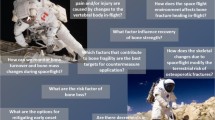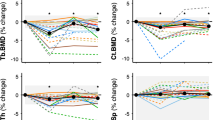Abstract
Currently, the measurement of areal bone mineral density (aBMD) is used at NASA to evaluate the effects of spaceflight on the skeletal health of astronauts. Notably, there are precipitous declines in aBMD with losses >10 % detected in the hip and spine in some astronauts following a typical 6-month mission in space. How those percentage changes in aBMD relate to fracture risk in the younger-aged astronaut is unknown. Given the unique set of risk factors that could be contributing to this bone loss (eg, adaptation to weightlessness, suboptimal diet, reduced physical activity, perturbed mineral metabolism), one might not expect skeletal changes due to spaceflight to be similar to skeletal changes due to aging. Consequently, dual-energy X-ray absorptiometry (DXA) measurement of aBMD may be too limiting to understand fracture probability in the astronaut during a long-duration mission and the risk for premature osteoporosis after return to Earth. Following a brief review of the current knowledge-base, this paper will discuss some innovative research projects being pursued at NASA to help understand skeletal health in astronauts.

Similar content being viewed by others
References
Papers of particular interest, published recently, have been highlighted as: • Of importance •• Of major importance
LeBlanc A, Schneider V, Shackelford L, et al. Bone mineral and lean tissue loss after long-duration spaceflight. J Musculoskelet Neuronal Interact. 2000;1(2):157–60.
Smith SM, Nillen JL, Leblanc A, et al. Collagen cross-link excretion during space flight and bed rest. J Clin Endocrinol Metab. 1998;83(10):3584–91.
Smith SM, Wastney ME, Morukov BV, et al. Calcium metabolism before, during, and after a 3-mo spaceflight: kinetic and biochemical changes. Am J Physiol. 1999;277(1 Pt 2):R1–R10.
Sibonga JD, Evans HJ, Sung HG, et al. Recovery of spaceflight-induced bone loss: bone mineral density after long-duration missions as fitted with an exponential function. Bone. 2007;41(6):973–8.
Amin S, Achenbach S, Atkinson EJ, et al. Bone density following three years of recovery from long-duration space flight. [abstract 2172] Presented at the18th Humans in Space Symposium of the International Academy of Astronautics. Houston, TX, April 11–15, 2011.
Lang T, LeBlanc A, Evans H, et al. Cortical and trabecular bone mineral loss from the spine and hip in long-duration spaceflight. J Bone Miner Res. 2004;19(6):1006–12.
Vico L, Collet P, Guignandon A, et al. Effects of long-term microgravity exposure on cancellous and cortical weight-bearing bones of cosmonauts. Lancet. 2000;355(9215):1607–11.
Black DM, Bouxsein ML, Marshall LM, et al. Proximal femoral structure and the prediction of hip fracture in men: a large prospective study using QCT. J Bone Miner Res. 2008;23(8):1326–33.
Keaveny TM, Hoffmann PF, Singh M, et al. Femoral bone strength and its relation to cortical and trabecular changes after treatment with PTH, Alendronate, and their combination as assessed by finite element analysis of quantitative CT scans. J Bone Miner Res. 2008;23(12):1974–82.
• Smith SM, Heer MA, Shackelford L, et al. Benefits for bone from resistance exercise and nutrition in long-duration spaceflight: evidence from biochemistry and densitometry. J Bone Miner Res. 2012;27(9):1–11. This paper reports that modifying risk factors for bone loss, ie, suboptimal nutrition and resistive exercise during spaceflight, improves the DXA aBMD outcome in ISS astronauts after ~ 6months in space.
Lang TF, LeBlanc AD, Evans HJ, et al. Adaptation of the proximal femur to skeletal reloading after long-duration spaceflight. J Bone Miner Res. 2006;21(8):1224–30.
Riggs BL, Melton III LJ, Robb RA, et al. Population-based assessment of rates of bone loss at multiple skeletal sites: evidence for substantial trabecular bone loss in young adult women and men. J Bone Miner Res. 2008;23(2):205–14.
• Carpenter RD, LeBlanc AD, Evans H, et al. Long-term changes in the density and structure of the human hip and spine after long-duration spaceflight. Acta Astronautica. 2010;67:71–81. QCT scans of hip detect the failure of the hip trabecular volumetric BMD to be restored to preflight levels in ISS astronauts by 2-years after return to Earth.
Keyak JH, Kaneko TS, Tehranzadeh J, et al. Predicting proximal femoral strength using structural engineering models. Clin Orthop Relat Res. 2005;437:219–28.
Keyak JH, Koyama AK, LeBlanc A, et al. Reduction in proximal femoral strength due to long-duration spaceflight. Bone. 2009;44(3):449–53.
Smith SM, Wastney ME, O’Brien KO, et al. Bone markers, calcium metabolism, and calcium kinetics during extended-duration space flight on the Mir space station. J Bone Miner Res. 2005;20(2):208–18.
Gaudio A, Pennisi P, Bratengeier C, et al. Increased sclerostin serum levels associated with bone formation and resorption markers in patients with immobilization-induced bone loss. J Clin Endocrinol Metab. 2010;95:2248–53.
Morse LR, Sudhakar S, Danilack V, et al. Association between sclerostin and bone density in chronic spinal cord injury. J Bone Miner Res. 2012;27:352–9.
Robling AG, Niziolet PJ, Baldridge LA, et al. Mechanical stimulation of bone in vivo reduces osteocyte expression of Sost/sclerostin. J Biol Chem. 2008;283:5866–75.
Spatz JM, Fields EE, Yu EW, et al. Serum sclerostin increases in healthy adult men during bed rest. J Clin Endocrinol Metab. 2012;97(9):E1736–40.
•• Orwoll ES, Adler RA, Amin S, et al. Invited review: skeletal health in long-duration astronauts: nature, assessment and management recommendations from the NASA Bone Summit. 2013. In press. This review paper outlines the recommendations of osteoporosis experts, charged with recommending a surveillance program for bone health in long-duration astronauts, after reviewing the bone-relevant research and medical data from 35 astronauts.
Nelson ES, Lewandowski B, Licata A, et al. Development and validation of a predictive bone fracture risk model for astronauts. Ann Biomed Eng. 2009;37(11):2337–59.
Orwoll ES, Marshall LM, Nielson CM, et al. Osteoporotic fractures in Med Study Group. Finite element analysis of the proximal femur and hip fracture risk in older men. J Bone Miner Res. 2009;24(3):475–83.
Keaveny TM, Kopperdahl DL, Melton III LJ, et al. Age-dependence of femoral strength in white women and men. J Bone Miner Res. 2010;25(5):994–1001.
Keyak JH, Sigurdsson S, Karlsdottir G, et al. Male–female differences in prediction of hip fracture during finite element analysis. Bone. 2011;48(6):1239–45.
Pothaud L, Carceller P, Hans D. Correlations between grey-level variations in 2D projection images (TBS) and 3D microarchitecture: applications in the study of human trabecular bone microarchitecture. Bone. 2008;42(4):775–87.
Rabier B, Heraud A, Grand-Lenois C, et al. A multicenter, retrospective case–control study assessing the role of trabecular bone scores (TBS) in menopausal Caucasian women with low areal bone mineral density (aBMD): analyzing the odds of vertebral fracture. Bone. 2010;46(10):176–81.
Disclosure
JD Sibonga declares that she has no conflicts of interest.
Author information
Authors and Affiliations
Corresponding author
Rights and permissions
About this article
Cite this article
Sibonga, J.D. Spaceflight-induced Bone Loss: Is there an Osteoporosis Risk?. Curr Osteoporos Rep 11, 92–98 (2013). https://doi.org/10.1007/s11914-013-0136-5
Published:
Issue Date:
DOI: https://doi.org/10.1007/s11914-013-0136-5




